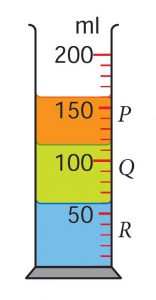Question 1:
Determine the density of the samples in the diagram below.

Answer:
A = 2 g cm–3,
B = 2 g cm–3,
C = 2 g cm–3
Determine the density of the samples in the diagram below.

Answer:
A = 2 g cm–3,
B = 2 g cm–3,
C = 2 g cm–3
Question 2:

Three types of liquid which do not mix, P, Q and R are poured together in a measuring cylinder as shown in the diagram. Which liquid is the most dense? Why?
Answer:
Liquid R, the most dense liquid will sink to the bottom

Three types of liquid which do not mix, P, Q and R are poured together in a measuring cylinder as shown in the diagram. Which liquid is the most dense? Why?
Answer:
Liquid R, the most dense liquid will sink to the bottom